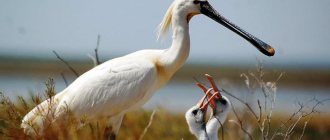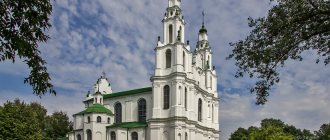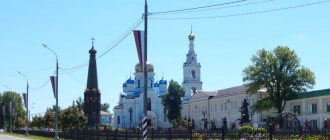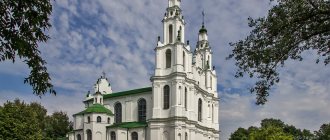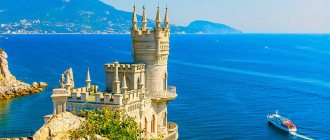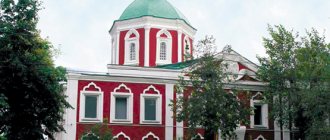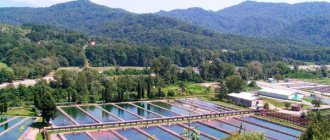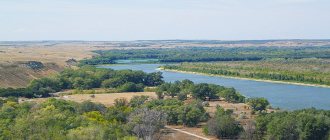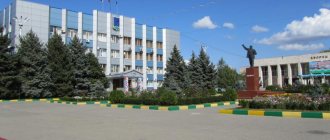Archaeological Museum-Reserve "Tanais"
Archaeological Museum-Reserve "Tanais".
Khutor Nedvigovka, Rostov region. Photo: Arestov Andrey Pavlovich / photobank “Lori” “Tanais” is one of the first archaeological reserves in Russia. It is located in the Nedvigovka village of the Rostov region. Almost five thousand years ago, the border between Europe and Asia passed here and a Greco-Scythian-Sarmatian-Maeotian city stood. Its traces were discovered by Soviet archaeologists in 1955.
The site of Tanais was the northernmost point of ancient civilization. Monuments of different cultures have been preserved here - from the Paleolithic to the 19th century. All exhibitions are outdoors. In the museum you can learn how the Tanait defended themselves from the enemy, cultivated wheat and fished. More than 140 thousand ancient objects tell about this, including a marble altar, ceramic dishes, women's jewelry, ancient fabrics of the 14th century and other artifacts.
The most interesting places in the Rostov region - TOP-3
A great number of natural monuments and reserves are registered on Rostov soil. Every tourist should see the most impressive creations of nature.
Biosphere Reserve "Rostovsky"
- Coordinates on the map: 46.464722, 43.050556.
The main natural reserve of the region has the status of a reserve of federal significance and covers the territory of the Remontnensky and Oryol districts, which is about 9,500 hectares. Most of the reserve, founded at the end of 1995, is occupied by endless desert steppes with saline soil, so the local flora is resistant to salts. The flora includes more than 400 species, 6 of which are included in the Red Book of Russia and another ten are listed in the Red Book of the region.
Many insects flock to the fragrant plants, including such rare species as the steppe bumblebee, Hungarian ground beetle and Bolivaria short-winged. Numerous birds nest near the river, including endangered species.
Wolves and foxes prowl along the valley steppes of the Manych River, horned saigas and delightful Manych mustangs gallop. In the grass you can see nimble field rodents, hares and hedgehogs. Tourists should be careful: there are a lot of snakes crawling on the ground, most of them are non-poisonous, but quite aggressive. Feeling a threat, reptiles can attack a person and bite the skin until they bleed.
Mountains Two Sisters
- GPS coordinates: 48.120571, 40.733055.
The two peaks are not the only mountains on the shore of the Northern Donets, but they stand out among their neighbors due to their height and extraordinary similarity to each other. Many people note that the twin mountains look like gigantic reptiles. It’s as if two huge lizards with protruding stone ridges have crawled to a watering hole and are lying side by side, with their heads directed towards the river.
The area has long been overgrown with myths and legends; the most famous one says that the peaks are enchanted sisters. Scientists give a very specific and realistic explanation for the natural phenomenon.
The hundred-meter-high mountains were formed about a million years ago as a result of the movement of the earth’s crust, when giant layers of limestone rose to the surface of the earth and over time became overgrown with greenery. Today, a floodplain forest separates the mountains at the foot, and clean freshwater springs rustle among the trees.
Long, or Long Canyon
- Coordinates: 48.228853, 40.349719.
A delightful canyon in the Kamensky district is a piece of the North American landscape in the middle of the steppe of the Rostov region. At the foot of the cliff flows an azure river, whose waters are so clean and transparent that through them you can see almost every pebble at the bottom.
Oddly enough, this amazing attraction appeared only in the last century and partly due to the fault of man. During Soviet times, there was a quarry here where stone was mined for construction work.
One day the quarry began to fill with groundwater and the huge pit was flooded to the very top in a matter of hours. Some of the equipment remained under water, which they did not have time to lift to a higher ground. The river is still fed by underground springs, so its waters remain cold even in hot weather.
Merzhanovsky lighthouse
- Address: Merzhanovo village, Neklinovsky district.
Not far from Taganrog, near the village of Merzhanovo, there is this man-made landmark of the Rostov region, which appeared relatively recently - as a set for the film “The Lighthouse Keeper”. Today, tourists happily visit this exciting place, mentally immersing itself in the distant past.
Loga Park
- Address: Loga Park, village. Staraya Stanitsa
In the area of the village of Staraya Stanitsa, near Kamensk-Shakhtinsky, there is Loga Park, where visitors can enjoy a lot of interesting entertainment and attractions, including the most popular - Crooked Mirrors. This place was included in our rating because it is truly unique - there are only a few like it in all of Russia. As the reviews say, when you relax here, you relax your soul!
Southern Bird Park "Malinki"
- Address: Krasny Sulin, PSH Sokolovskoye.
An interesting recreation park of regional significance is located near Novoshakhtinsk. “Malinka” itself will delight you with a unique “collection” of birds that you can see with the whole family. The territory is well designed, there is a lot of interesting things here, there are gazebos and bungalows near the shore of a neighboring reservoir, and beaches.
Novocherkassk Holy Ascension Cathedral
Novocherkassk Holy Ascension Cathedral. Novocherkassk, Rostov region. Photo: Yakovlev Andrey Alexandrovich / photobank “Lori”
Novocherkassk Holy Ascension Cathedral is a historical monument of the Don Cossacks. It is the third largest in Russia after the Cathedral of Christ the Savior and St. Isaac's Cathedral. The cross on the main dome is decorated with rock crystal crystals with diamond edges. They shine so brightly that the cathedral is even called “the second sun of the Don.”
Inside the temple, the walls are painted with frescoes, and the choirs (balconies) are decorated with paintings on scenes from the history of the local Cossacks: “Ermak’s preparations for the campaign in Siberia”, “Grant of the Tsar’s Banner under Tsar Mikhail Fedorovich in 1614”, “Azov Seat in 1641” and many other. The lower temple-tomb was consecrated in honor of the Intercession of the Most Holy Theotokos. Sarcophagi are installed here in which the founder of Novocherkassk Matvey Platov and the heroes of the Patriotic War of 1812 rest: Vasily Orlov-Denisov, Ivan Efremov, Pyotr Baklanov and others.
Relaxation on the beaches of the Azov Sea
You can spend your vacation on the Sea of Azov in the Taganrog region. It will cost less than a holiday on the Black Sea coast. The climate here is drier and hotter than in Crimea, but this is compensated by lower prices for housing and food.
Accommodation is booked in advance online, but even if there is no reservation, renting a room on the day of arrival is not a problem.
For a comfortable stay there are recreation centers, boarding houses and sanatoriums. They are dispersed along the entire coast.
The beaches of the Azov Sea are only sandy. Local residents and tourists are advised to come here before mid-July, as the sea begins to bloom in the second half of summer.
State Museum-Reserve M.A. Sholokhov
Memorial House M.A. Sholokhov in the Kruzhilinsky farm. Village Vyoshenskaya, Rostov region. Photo: sholokhov.ru
The Mikhail Sholokhov Museum-Reserve is the only state museum of the writer in Russia. It includes a memorial house in the village of Kruzhilinsky, where Sholokhov was born, a house-museum in the village of Karginskaya, where he wrote “Don Stories,” a house in the village of Veshenskaya, in which the writer worked on “Quiet Don” and “Virgin Soil Upturned,” as well as memorial estate where the Sholokhovs lived from 1949 to 1984.
The museum exhibits tell about the life and work of the writer. Among them are personal belongings of Sholokhov and his family: books, manuscripts, photographs, film and sound recordings, documents, illustrations for books and first editions of works. Also here you can see a unique exhibition “Novel in the Open Air”: its exhibits are the farms and villages described in the novel “Quiet Don”.
Pavlovsk Fortress
The Pavlovsk fortress is the first outstanding example of military art in the Rostov region and Russia, which was designed using precise engineering and mathematical methods: it is a quadrangle with bastions extended at the corners.
Pavlovsk Fortress is unique and beautiful. It was founded in July 1697 by order of Peter I by engineer Lasval. It was built where the Mius River flows into the estuary located near the village of Gaevka. The steep banks of the estuary significantly strengthened the defense of the fortress from the attacks of the Crimean Tatars.
Surb-Khach Church in Rostov-on-Don
Church of Surb-Khach. Rostov-on-Don. Photo: Viktor Filippovich Pogontsev / photobank “Lori”
The Surb-Khach Church is one of the most ancient in Rostov-on-Don. It was built according to the design of the architect Ivan Starov at the end of the 18th century. The walls of the temple in the classicist style were decorated with khachkars - ancient stone steles with images of crosses. In 1862, the church was rebuilt, and a two-tier bell tower with a high tent was erected nearby. At the monastery there was a seminary and the first printing house in the south of Russia. Over time, the temple began to collapse, but in 1968–1972 it was restored. The Museum of Russian-Armenian Friendship was opened here.
Today Surb-Khach is an Armenian Apostolic Church. The temple and the surrounding park are located on the right bank of the Northern Reservoir, and a spring flows from under the hill on which it stands. Armenian poets and public figures are buried near the walls of Surb Khach: Harutyun Alamdaryan, Mikael Nalbandyan, Rafael Patkanyan.
Geography
The straight line distance from Moscow is 756 km. One of the largest rivers in Europe, the Don (length 1870 km), flows through the region, and the Tsimlyanskoye Reservoir (volume 24 billion m³) is located. The main tributaries of the Don are navigable: the Seversky Donets and Manych rivers. Lakes occupy only 0.4% of the region's territory. Part of the hydropower potential is realized at the Tsimlyanskaya HPP in the amount of 630 million kWh. In the southwest, the region is washed by the Taganrog Bay of the Sea of Azov.
Mineral raw materials include a group of fuel and energy resources, among them - coal of the Eastern Donbass, especially anthracite, the best in the world in terms of calorific value. Deposits of nonmetallic raw materials for metallurgy and the production of building materials are being developed. Explored gas reserves are estimated at 56.2 billion m³. There are also deposits of iron ore, fluxing limestone, building materials, table salt, and natural gas.
The forest fund of the region is insignificant, represented on 2.8% of the territory, mostly by forests that perform water protection and protective functions.
Monument to Matvey Platov in Novocherkassk
Monument to Ataman Matvey Platov. Novocherkassk, Rostov region. Photo: Boris Panasyuk / photobank “Lori”
The monument to the Don Ataman, hero of the Patriotic War of 1812 and founder of Novocherkassk Matvey Platov is the first sculptural monument of the city. It was installed in 1853 - on the centenary of Platov’s birth. During Soviet times, the monument was destroyed and restored in the 1990s.
The figure of Platov stands on a high pedestal. He was depicted in a general's uniform and a burka - a sleeveless felt cloak. In his left hand the chieftain holds a mace, and in his right hand a saber. The memorial plaque reads: “To Ataman Count Platov for military exploits from 1770 to 1816. Grateful people of the Don."
Sadovaya street
Bolshaya Sadovaya Street is a landmark of the city. There are many amazingly beautiful architectural buildings, merchant houses, and monuments here.
At the corner of Sadovaya Street and Khalturinsky Lane there is a house built with the money of the merchant of the first guild Paramonov for the actress Margarita Chernova.
The architectural style of the house is Baroque: the facades are decorated with rich stucco, masks, atlases and caryatids.
Walking further along the odd side of the street towards larger rooms, guests of the city will meet a sculptural image of the merchant Ivan Aleksandrovich Suprunov, a famous horse breeder and producer of flour, which was famous throughout Europe.
At the entrance to the cultural park named after. Gorky, you can take a photo next to the symbolic monument to the merchant-peddler with a cat.
We draw your attention to the city administration building.
It was built in 1889 and is an architectural masterpiece in the eclectic style.
Monument to Ermak in Novocherkassk
Monument to Ataman Ermak. Novocherkassk, Rostov region. Photo: Oleg Pchelov / photobank “Lori”
The monument to the Cossack ataman, the conqueror of Siberia Ermak, is one of the symbols of Novocherkassk. It is located on Cathedral Square in the city center. The sculpture was erected in the capital of the Don Cossacks in 1904, almost 35 years after the celebration of the 300th anniversary of the Don Army.
The four-meter figure of Ermak is installed on a high granite block, and the total height of the monument is 12 meters. In the ataman’s left hand is a marching banner, and in his right hand he holds the crown of the ruler of Siberia he conquered. Several inscriptions are carved on the pedestal, including the words of the writer and historian Nikolai Karamzin: “Russia, history and the church proclaim eternal memory to Ermak.”
Literary Museum A.P. Chekhov
Literary Museum A.P. Chekhov. The building of the former men's classical gymnasium. Taganrog, Rostov region. Photo: Mikhail Markovsky / photobank “Lori”
The Anton Chekhov Literary Museum is located in Taganrog, in the building of a former men's gymnasium - the oldest educational institution in the South of Russia. The writer studied here for 11 years. Until 1975, a secondary school operated in the building, which bore his name.
The exhibition “The Writer and the Motherland” tells about Chekhov’s life in Taganrog. For the 150th anniversary of the writer’s birth, which was celebrated in 2010, a new exhibition was opened here. In it you can see books that were given to Chekhov by famous artists, performers and musicians, as well as photographs and his personal belongings: a hat, jacket, gloves.
Taganrog Museum of History and Local Lore
Taganrog Museum of History and Local Lore. Taganrog, Rostov region. Photo: Alina Sbitneva / photobank “Lori”
The Taganrog Museum of History and Local Lore was opened on the initiative of Chekhov in 1898. It is located in an ancient building, which was built in the mid-19th century by St. Petersburg architect Andrei Stackenschneider in 1848. The palace belonged to Taganrog homeowner Nikolai Alferaki.
The museum exhibits are located in 15 halls. They talk about the history, culture and archeology of the Don region. Artifacts of the Stone Age culture, which were discovered on the territory of the North-Eastern Azov region, are stored here, as well as items made of bone, bronze and stone found during excavations of the Nizhne-Gnilovsky settlement, one of the six ancient city-states on the coast of Asia Minor.
High mountains and rocks in the Rostov region
The region's territory is predominantly flat, but its proximity to the Caucasus makes itself felt. In different parts of the region, remarkable mountains and cliffs rise, which look especially impressive against the backdrop of the steppes.
Avilovskie, or Avilov, mountains
- Coordinates: 48.184326, 40.807408.
The high cliffs in the vicinity of the city of Belaya Kalitva belong to the ancient Sarmatian mountains. The mountain slopes are covered with sparse vegetation, and well-trodden paths lead to the peaks. From the height there is a wonderful view of the Kalitva River, the city in the distance and the even rectangles of summer cottages.
Local residents like to fish at the foot of the mountains, and above them the black mouth of the Avilovskaya cave gapes. It is believed that the cave, like the mountains themselves, received the name of the hermit monk Avila, who escaped here many years ago.
Chalk Mountains
- Coordinates: 48.919645, 40.026822.
The remote Millerovsky district is fraught with a real pearl - entire mountains of chalk. The snow-white miracle of nature was formed millions of years ago, when an endless sea splashed in these parts. Islands of herbs and shrubs appear on the chalk slopes. In the spring, lemon thyme makes its way through the limestone deposits. The fantastic landscape is complemented by old dilapidated towers.
Mount Gorodishche
- Coordinates: 48.783333, 40.833333.
An amazing mountain flaunts not far from the Aleksandrovskaya settlement. The sand is replaced by stone boulders covered with moss and lichen, which, according to local residents, are becoming larger every year. In the stone kingdom there was also a place for living nature: the slopes are covered with centuries-old oaks and pines, and lilies of the valley grow on the top. The mountain is crowned with an observation tower.
There are several caves inside the mountain, and the underground passages hold many surprises. Thus, in some of them traces of primitive man were found - tools, dishes and inscriptions on the walls. It was because of the ancient sites that the peak received the name Gorodishche. Many centuries later, robbers were hiding on the mountain. Unfortunately, many finds were lost as a result of landslides: the tunnels were filled with sand and stones.
The settlement is shrouded in legends. According to one of them, a freshwater lake is hidden inside. Scientists were never able to find a reservoir, but they were able to determine from some signs that there may be sources of water in the depths of the mountain.
skeletal rock
- Coordinates: 47.906161, 40.038642.
A curious rock with a funny name rises near the village of Skelevatka in the Krasnosulinsky district. A kilometer-long wall up to 25 meters high protects the settlement from the winds. The sheer cliff attracts experienced rock climbers; it is not surprising that extreme sports enthusiasts often set up tent camps at its foot. The landscape of Skelevataya pleases the eye even for ordinary tourists; rare shrubs grow green on the reddish slopes, and a girder forest rustles in the north of the rock.
House-Museum of I.D. Vasilenko
House-museum of the writer I.D. Vasilenko. Taganrog, Rostov region. Photo: tgliamz.ru
The house-museum of the Soviet writer Ivan Vasilenko is located in Taganrog. He lived here with his family from 1923 to 1966, until his death. In this house, Vasilenko wrote several stories for children: “Star”, “The Life and Adventures of Zamorysh”, “Artemka in the Circus”, “The Magic Box”. In 2004, an exhibition was opened here where you can see the writer’s personal belongings, documents, drafts, journals and photographs. Four years later, an exhibition dedicated to the “Cycle of Works about Artemka,” one of Vasilenko’s main children’s characters, appeared in the house. The museum also houses an exhibition of paintings by artist Mikhail Sychev, a friend of Ivan Vasilenko.
Author: Irina Malakhova
